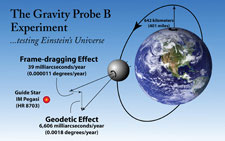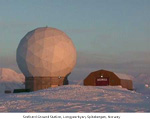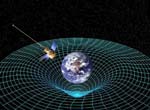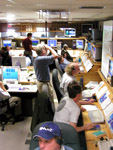WEEKLY HIGHLIGHTS FOR 10 DECEMBER 2004:
GRAVITY PROBE B MISSION UPDATE

Now, almost 34 weeks in orbit, the GP-B spacecraft is in fine health, with all subsystems continuing to perform well. The spacecraft, which is in the middle of a 6-week un-eclipsed (full sun) period, is flying drag-free around gyro #3, maintaining a constant roll rate of 0.7742 rpm (77.5 seconds per revolution.) The temperature inside the Dewar is holding steady at just under 1.82 kelvin. All four gyros are digitally suspended in science mode. We have been collecting relativity data for 15 weeks. The data collection process is continuing to proceed smoothly, and the quality of the data continues to be excellent.
For much of the month of December, our Mission Planning staff has scheduled minimal spacecraft activity, outside routine monitoring of spacecraft functionality and downloading of science data. However, lest we become complacent, Mother Nature seems to have a way of stirring up the pot—as was the case last Saturday afternoon.
THE SPACECRAFT'S TALE
 Last Saturday began as a rather “ho-hum” California winter’s day. Orbiting the Earth every 97.5 minutes, the GP-B spacecraft passed directly over California around 6:30AM PST, but the Sun was already up, and the sky was too bright to see the satellite. In the GP-B Mission Operations Center (MOC), a skeleton crew consisting of the on-duty Mission and Flight directors and one or two resident engineers monitored several telemetry passes (communications sessions) during the morning hours. Most were 25-minute satellite passes, during which the spacecraft relays status information to the MOC through the NASA TDRS (Tracking and Data Relay Satellite) communications satellite system. And, during a 12-minute ground pass at 1:15PM PST, the spacecraft’s solid-state recorder relayed relativity data to the GP-B science database through a high-speed telemetry connection with the Svalbard ground tracking station, on the island of Spitsbergen in Norway. All in all, it was a normal Saturday, and the atmosphere in the MOC was quite relaxed.
Last Saturday began as a rather “ho-hum” California winter’s day. Orbiting the Earth every 97.5 minutes, the GP-B spacecraft passed directly over California around 6:30AM PST, but the Sun was already up, and the sky was too bright to see the satellite. In the GP-B Mission Operations Center (MOC), a skeleton crew consisting of the on-duty Mission and Flight directors and one or two resident engineers monitored several telemetry passes (communications sessions) during the morning hours. Most were 25-minute satellite passes, during which the spacecraft relays status information to the MOC through the NASA TDRS (Tracking and Data Relay Satellite) communications satellite system. And, during a 12-minute ground pass at 1:15PM PST, the spacecraft’s solid-state recorder relayed relativity data to the GP-B science database through a high-speed telemetry connection with the Svalbard ground tracking station, on the island of Spitsbergen in Norway. All in all, it was a normal Saturday, and the atmosphere in the MOC was quite relaxed.
Following the successful ground pass with Svalbard, the spacecraft continued on its southward route. At around 1:30 PM PST, Pacific time, the spacecraft was flying over South America—heading towards the South Pole—when it entered the South Atlantic Anomaly (SAA). This is a region above the Earth where the fluxes of trapped protons and other particles, emitted by the Sun, are much greater than anywhere else on Earth, due to the asymmetry of the Earth’s protective Van Allen Radiation Belts. Thus, spacecraft are more vulnerable to being struck by protons when flying through this region.
 At 1:48PM, Pacific Time, an odd event silently occurred on-board the spacecraft, triggering four safemodes (pre-programmed command sequences designed to automatically place the spacecraft, its gyros, telescope, and other systems and instruments, in a stable and safe configuration in response to anomalous or out-of-limits feedback from various on-board sensors).
At 1:48PM, Pacific Time, an odd event silently occurred on-board the spacecraft, triggering four safemodes (pre-programmed command sequences designed to automatically place the spacecraft, its gyros, telescope, and other systems and instruments, in a stable and safe configuration in response to anomalous or out-of-limits feedback from various on-board sensors).
Back in the MOC, the next telemetry pass was not scheduled until 3:16 PM, so the operations staff was completely unaware of this change in the spacecraft’s condition—for the time being. At 3:15PM, the MOC staff settled into their seats for the upcoming satellite status telemetry pass. As the spacecraft’s antenna locked into the TDRSS satellite and began transmitting, one-by-one, status monitors around the MOC began turning red, signaling the spacecraft had triggered its safemodes. There is a problem on-board.
During the next 20 minutes, phones rang, pagers beeped, and soon, the MOC was teeming with activity. An assessment of the safemodes that were triggered indicated that an error—never seen before--had occurred in a module of the Attitude and Translation Control (ATC) computer system. The spacecraft’s GPS had registered an off-the-scale velocity spike, which if correct, indicated that, for one brief moment, the spacecraft had traveled faster than the speed of light—or to use Star Trek terminology, it had “warped into hyperspace.” In fact, the GPS system had reported a single data point with an erroneously high velocity, which when squared, caused a computer overflow. The ATC computer module took exception to this data overflow and triggered a safemode test, which in turn activated a chain reaction response sequence.
The MOC staff immediately scheduled several extra satellite communication passes so they could communicate with the spacecraft more frequently. Then, over the ensuing 24 hours, they methodically worked through a series of tests and command sequences to return the spacecraft to its normal science operation mode. We initially assumed that the GPS receiver had suffered a proton hit in the SAA region, but further analysis suggests that this was not the case. Rather, this anomaly was apparently caused by one of the four accessible GPS satellites being in the wrong position for proper GPS triangulation. The ATC system usually catches situations of this kind and disallows the data; but, this one slipped through the filter.
The spacecraft has returned to normal operations. This incident was not detrimental to the GP-B experimental data. And, once again, the fact that an anomalous event occurred while the spacecraft was flying through the SAA region appears to be a coincidence—or is it?
THE EINSTEIN EXHIBITION AT THE SKIRBALL CULTRAL CENTER IN LOS ANGELES
 If you're going to be in Los Angeles anytime before 30 May 2005, and if you’re interested in Einstein’s life and work, the Einstein Exhibition at the Skirball Cultural Center (just north of the Getty Museum on Interstate 405) is the most comprehensive presentation ever mounted on the life and theories of Albert Einstein (1879-1955). It explores his legacy not only as a scientific genius who re-configured our concepts of space and time, but also as a complex man engaged in the social and political issues of his era. It examines the phenomenon of his fame and his enduring status as a global icon whose likeness has become virtually synonymous with genius.
If you're going to be in Los Angeles anytime before 30 May 2005, and if you’re interested in Einstein’s life and work, the Einstein Exhibition at the Skirball Cultural Center (just north of the Getty Museum on Interstate 405) is the most comprehensive presentation ever mounted on the life and theories of Albert Einstein (1879-1955). It explores his legacy not only as a scientific genius who re-configured our concepts of space and time, but also as a complex man engaged in the social and political issues of his era. It examines the phenomenon of his fame and his enduring status as a global icon whose likeness has become virtually synonymous with genius.
In this exhibit, you can examine Einstein's report card, inspect his FBI file, and enjoy his family photographs, love letters, and diary entries. Exhibition highlights include scientific manuscripts and original correspondence—including original handwritten pages from the 1912 manuscripts of the special theory of relativity and his 1939 letter to President Roosevelt about nuclear power—and a wealth of other documents from the Albert Einstein Archives at the Hebrew University of Jerusalem.



In addition to these displays of Einstein memorabilia, the exhibit also features a number of interactive components that help provide an understanding of Einstein's revolutionary theories. Furthermore, several “explainers,” identified by their red aprons, are on hand to discuss various aspects of the exhibit and to explain and demonstrate difficult concepts, such as time dilation and warped spacetime. At the end of the exhibit, you’ll find one of GP-B’s gyro rotors on display.
The Einstein exhibition was jointly organized by the American Museum of Natural History (AMNH), the Hebrew University of Jerusalem, and the Skirball Cultural Center. It was designed by the AMNH under the supervision of Dr. Michael Shara, curator of the exhibit and chairman of the museum’s Astrophysics Department. It opened in November 2002 at the AMNH in New York and then traveled to Chicago and Boston, spending about 8 months in each location. It will remain at its final U.S. stop at the Skirball Center in Los Angeles through 29 May 2005, after which time it will move permanently to the Hebrew University in Jerusalem.
Information about the Einstein exhibition is available on the Skirball Center Web site. If you can’t make it to Los Angeles, you can visit the AMNH’s virtual Einstein exhibit on the Web.
Drawings & photos: The two diagrams of the GP-B experiment and the map showing the South Atlantic Anomaly (SAA) region are from the GP-B Image Archives here at Stanford. The photo of the Svalbard Ground Station is courtesy of NASA. The photo of activity in the GP-B Mission Operations Center (MOC) was taken by GP-B Public Affairs Coordinator, Bob Kahn. The photos from the Einstein Exhibit are courtesy of the Skirball Cultural Center. Click on the thumbnails to view these images at full size.
Please Note: Until further notice, we intend to continue posting these GP-B highlights on a weekly basis. Also, from time to time, we may post special reports and special updates, as warranted by mission events.
More links on recent topics
- Track the satellite in the sky
- Photo, video & and news links
- Build a paper model of the GP-B Spacecraft
- Following the mission online
- Our mailing list - receive the weekly highlights via email
- The GP-B Launch Companion in Adobe Acrobat PDF format. Please note: this file is 1.6 MB, so it may take awhile to download if you have a slow Internet connection.
Previous Highlight
Index of Highlights


